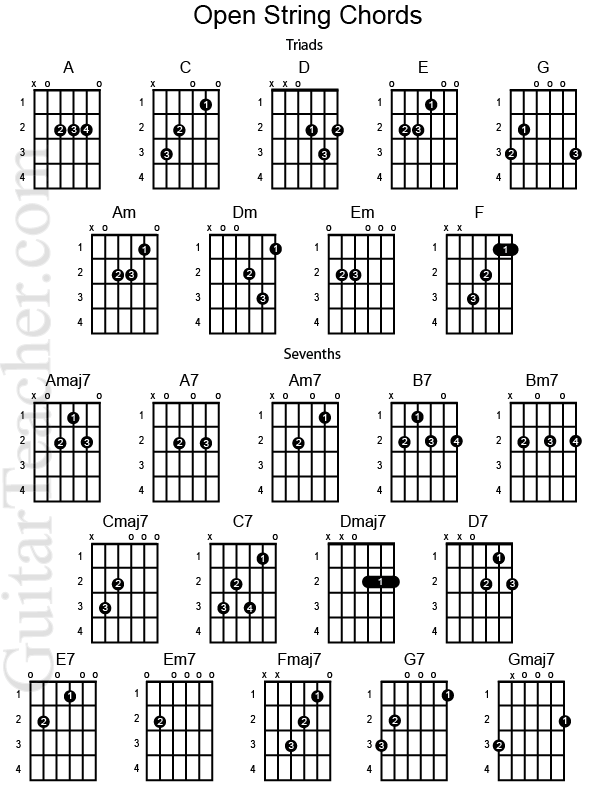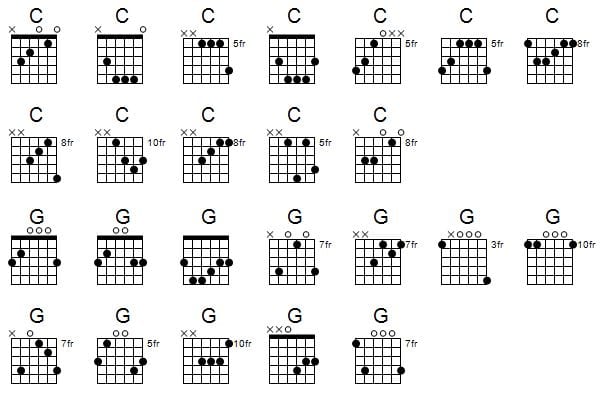Play all family and transpose with breeze
Guitar Chords voicing is basically playing the same chord at different position on the finger board or the neck of the guitar
Why 1, 4, 5 is Major? Why 2, 3, 6 Minor? Why 7 is Diminish
Interval of 2 is Major 3rd, Interval of 1 1/2 is Minor 3rd
Interval of 1 1/2 Minor 5th, Interval of 2 is Major 5th
Chords Formations
Major: 1-3-5
Minor (-): b3 or (minor 3rd or flat 3rd), 1-b3-5
7th or Dominant 7th (C7 or Cdom7): b7 (or minor 7th), 1-3-5-b7
min7 (eg,C-7): b3, b7 (or minor 3rd and 7th), 1-b3-5-b7
Major7 (△) (eg, C△): add 7 (or add maj 7), 1-3-5-7
sus: suspend 3rd note, replaced by or add 2nd and 4th note, 1-2-4-5
sus2: suspend 3rd note, replaced by or add 2nd note, 1-2-5
sus4: suspend 3rd note, replaced by or add 4th note, 1-4-5
Diminished (o) (eg, C°): b3 and b5, 1-b3-b5-6(bb7)
Half Diminished (ø) (eg, Cø): 1-b3-b5-b7 (or min7b5)
Augmented (+) (eg, C+): #5, 1-3-#5
5 (C5): Power Chord, 1-5 or 1-5-1
6 (C6): Add 6, 1-3-5-6
9 (C9): 1-3-5-b7-9
Maj9 (Cmaj9): 1-3-5-7-9
2 (C2): Add 2, 1-2-3-5
Add9: Add 9, 1-3-5-9
C2 and Cadd9 is off the same tone because 2 and 9 is the same tone
Diminished or Diminished 7th (♭♭7)(dim, °, dim7, °7), C° of C°7 : 1, ♭3, ♭5, ♭♭7 (6) (3HS - 3HS - 3HS)
Half Diminished (♭7)(ø) (m7b5, -7b5, (∅) Eg Cm7(♭5), Cø or Cø7: 1, ♭3, ♭5, ♭7 (3HS - 3HS - 4HS)
C△ = Major
C- = Minor
C+ = Augmented
Cø = Half Diminished (1-b3-b5-b7) = Cm7b5
C° or C°7 = Full Diminished (1-b3-b5-6) or (1-b3-b5-bb7)
For more chords, refer to Guitar Chords Library
Gsus2 (1-2-5, G-A-D) = Dsus4 (1-4-5, D-G-A)
Hence:
Csus2 = Gsus4
Dsus2 = Asus4
Esus2 = Bsus4
Fsus2 = Csus4
Gsus2 = Dsus4
Asus2 = Esus4
Bsus2 = F#sus4
C6 (1-3-5-6, C-E-G-A) = Am7 (1-b3-5-b7, A-C-E-G)
Hence
C6 = Am7
D6 = Bm7
E6 = C#m7
F6 = Dm7
G6 = Em7
A6 = F#m7
B6 = G#m7
Diminished Chords (dim, °, dim7, °7) : 1-b3-b5-6(bb7) (3 HS - 3HS - 3HS)
(HS: Half Steps)
D# A C F#
The above Chord Shape is based on C° (1-b3-b5-bb7) (C-D#-F#-A) = Full Diminished. (1-3HS-3HS-3HS)
C° or C°7 (1-b3-b5-bb7) or (1-b3-b5-6) (C-D#-F#-A)
C° = A° = D#° = F#° (Fret 1, 4, 7, 10)
C° or C°7: C D#/Eb F#/Gb AA° or A°7: A C D#/Eb F#/Gb
D° = F° = B° = G#° (Fret 0, 3, 6, 9)
D° or D°7: D F G#/Ab B
F° or F°7: F G#/Ab B D
B° or B°7: B D F G#/Ab
E° = G° = C#° = A#° (Fret 2, 5, 8, 11)
E° or E°7: E G A#/Bb C#/Db
G° or G°7: G A#/Bb C#/Db E
Example
HS: Half Step
B° (1-b3-b5) = Natural Diminished. (1-3HS-3HS)
Bø (1-b3-b5-b7) = Half Diminished. (1-3HS-3HS-4HS)
B°7 (1-b3-b5-bb7) = Full Diminished. (1-3HS-3HS-3HS)
(1-b3-b5-6) = Full Diminished. (1-3HS-3HS-3HS)
Bø = Bm7b5 (1-b3-b5-b7) = Half Diminished. (1-3HS-3HS-4HS)
Bø7 = Bm7b5 (1-b3-b5-b7) = Half Diminished. (1-3HS-3HS-4HS)
B°7 1 b3 b5 bb7
B D F G#
Bm7 1 b3 5 b7
B D F# A
Bm7b5 1 b3 b5 b7
B D F A
Bm7#5/b6 1 b3 #5/b6 b7
B D G A
Harmonic Chords: By strumming
Melodic Chords: By Plucking or picking, broken chords, Arpeeggios playing style









































Chord Formulas
( ) = OPTIONAL NOTEMAJOR
| Chord Type | Symbol | Formula |
|---|---|---|
| Major | M, Maj | 1-3-5 |
| Added Fourth | add4 | 1-3-4-5 |
| Sixth | 6 | 1-3-5-6 |
| Six Nine | 6/9 | 1-3-5-6-9 |
| Major 7th | Maj7 | 1-3-5-7 |
| Major Ninth | Maj9 | 1-3-5-7-9 |
| Major Eleventh | Maj11 | 1-3-5-7- (9)-11 |
| Major Thirteenth | Maj13 | 1-3-5-7-(9)-(11)-13 |
| Major seven sharp eleventh | Maj7#11 | 1-3-5-7- #11 |
| Major Flat Five | - | 1-3-b5 |
MINOR
| Chord Type | Symbol | Formula |
|---|---|---|
| Minor | m | 1-b3-5 |
| Minor added fourth | madd4 | 1-b3-4-5 |
| Minor sixth | m6 | 1-b3-5-6 |
| Minor seventh | m7 | 1-b3-5-b7 |
| Minor added ninth | madd9 | 1-b3-5-9 |
| Minor six add nine | m6/9 | 1-b3-5-6-9 |
| Minor ninth | m9 | 1-b3-5-b7-9 |
| Minor eleventh | m11 | 1-b3-5-b7-(9)-11 |
| Minor thirteenth | m13 | 1-b3-5-b7-(9)-(11)-13 |
| Minor/Major seventh | m/Maj7 | 1-b3-5-7 |
| Minor/Major ninth | m/Maj9 | 1-b3-5-7-9 |
| Minor/Major eleventh | m/Maj11 | 1-b3-5-7-(9)-11 |
| Minor/Major thirteenth | m/Maj13 | 1-b3-5-7-(9)-(11)-13 |
| Minor seven flat fifth | m7-5 or ø | 1-b3-b5-b7 |
| Chord Type | Symbol | Formula |
|---|---|---|
| Seventh | 7 | 1-3-5-b7 |
| Ninth | 9 | 1-3-5-b7-9 |
| Eleventh | 11 | 1-(3)-5-b7-(9)-11 |
| Thirteenth | 13 | 1-3-5-b7-(9)-(11)-13 |
| Seven sharp five | 7#5 | 1-3-#5-b7 |
| Seven flat five | 7b5 | 1-3-b5-b7 |
| Seven flat ninth | 7b9 | 1-3-5-b7-b9 |
| Seven sharp ninth | 7#9 | 1-3-5-b7-#9 |
| Nine sharp five | 9#5 | 1-3-#5-b7-9 |
| Nine flat five | 9b5 | 1-3-b5-b7-9 |
| Seven sharp five sharp nine | 7#5#9 | 1-3-#5-b7-#9 |
| Seven sharp five flat nine | 7#5b9 | 1-3-#5-b7-b9 |
| Seven flat five sharp nine | 7b5#9 | 1-3-b5-b7-#9 |
| Seven flat five flat nine | 7b5b9 | 1-3-b5-b7-b9 |
| Seven sharp eleven | 7#11 | 1-3-5-b7-#11 |
Symmetrical
| Diminished | dim (° ) | 1-b3-b5 |
| Diminished Seventh | dim7 (°7) | 1-b3-b5-bb7 |
| Augmented | aug (+) | 1-3-#5 |
Miscellaneous
This section contains diadic "fifth" (2 note 'chords'),
the "Sus" chords, and the #11. A #11 contains a perfect fifth
as well as a sharp eleven, (which is the same note as a flat five but an octave higher).
These chords do not have a Major or Minor tonality, since there is no 3rd. However the #11 chord does have a Lydian sound.
| Chord Type | Symbol | Formula |
|---|---|---|
| Fifth | 5 | 1-5 |
| Flat Fifth | -5 | 1-b5 |
| Suspended Fourth | sus4 | 1-4-5 |
| Suspended Second | sus2 | 1-2(9)-5 |
| Sharp Eleven | #11 | 1-5-#11 |
3 Alternate Chord Options
1 2 4 6
1 C Family C Bm F Am
1 3 5 6
4 F Family F Am C Dm
1 3 5 6
1 C Family C Em G Am
1 2 4 6
5 G Family G Am C Em
1 2 4 6
1 D Family D Em G Bm
1 3 5 6
4 G Family G Bm D Em
1 3 5 6
1 D Family D F#m A Bm
1 2 4 6
5 A Family A Bm D F#m
1 2 4 6
1 E Family E G#m A C#m
1 3 5 6
4 A Family A C#m E F#m
1 3 5 6
1 E Family E G#m B C#m
1 2 4 6
5 B Family B C#m E G#m
Chord Options / Chord Melody / Color Chords
Chord Melody Concept - Playing Chords and Melodies together
Chord Melodies
- Getting the melody and write them down
- Follow the chord shape of the song and put in melody, likely using sus2, sus4 and other color chords or transitional chords, sometimes add in other major and minor chords within the same family in order to get the melody sound while strumming the chords
Easy Pattern Tells You Every Chord In Every Key
Passing Chords
Passing Chords
Passing Chords is usually 5th to Root Chord
Eg Chord Progression
C G D Em
4 1 5 6
Add Passing Chords
C G D B Em Dm G/B
4 1 5 6
To add 1 Passing Chord before Em, Add B(B7). Em F G A B(B7) (B is 5th of Em)
To add 2 Passing Chords before C, Add G(G7). C D E F G (G is 5th of C)
Add another before G(G7), Add Dm(Dm7). G A B C D (D is 5th of G)
Passing Chords
https://m.youtube.com/watch?v=b8O8jcj-qrk
Method 1: Chord family, Every 1 note has 3 possible chords (1, 3, 6, C, Em, Am)
Method 2: Use dom7th, 5th chord
Method 3: Use of 2-5-1. (Target chord is C, then Dm7-G7-C) Use 7th chord to Jezz it up.
Method 4: Use color chords, sus2, sus4
Walking Bass between Chords on guitar
Concept of Phrasing
Concept of Phrasing in Singing
- Which word to drag, drag for how long and which are the words to be joined
- Add dynamics to the phrase (where to be loud and put emphasize and where to be soft)
- Where to breath
We can also apply the above phrasing techniques into guitar dynamic
Using Triad. The 3 Notes that will FOREVER Unlock Your ENTIRE Fretboard
https://m.youtube.com/watch?v=O5jkY1--qZA
Guitar Journey
Beginner
Learn the Chord Shapes, Likely C, F, G and G, C, D
Simple down strumming, Likely, 1,2,3,4
Strum simple songs with 3 chords
Intermediate
Learn more Chord Shapes, Likely, whole of C Family, D Family, G Family, A Family
Able to change chord fast enough
Memorize the above shapes
Some basic 8 beat downstrokes and upstrokes strumming
Basic Plucking 8 beat
Able to play some bar chords
Advance
Memorized the chord shapes and Proficient in C, D, E, G, A Family
No problem with chords changing and no buzzing sound
Able to play 8 beats and 16 beats strumming
Able to play basic 8 beats plucking
Able to play many Bar Chords (E shape, Am shape, A shape bar chords)
Able to play at least 10 strumming patterns
Able to play at least 3 plucking patterns
Play Palm muting
Play pluck slap muting
Slide down up up down strumming
Know the various capo positions when play in different keys
More Advance
Chord Melody, Color Chords
Walk up or Walk down bass
Supporting by playing inner frets
Basic Pantatonic supporting
Able to play melody with for every chord families
Able to play chord melody solo the entire song
Varying strumming patterns at different section of the song and do some fill-ins
Varying plucking patterns at different section of the song
Play with guitar dynamics throughout the song
Able to identify the key of the song of the original singer or pick up the key when someone sings
Able to play by ear
Music Theory
- Chords Formation
- CAGED
- Play open chords at inner neck
Guitar Ensemble
1 strum, 1 pluck, 1 melody











No comments:
Post a Comment